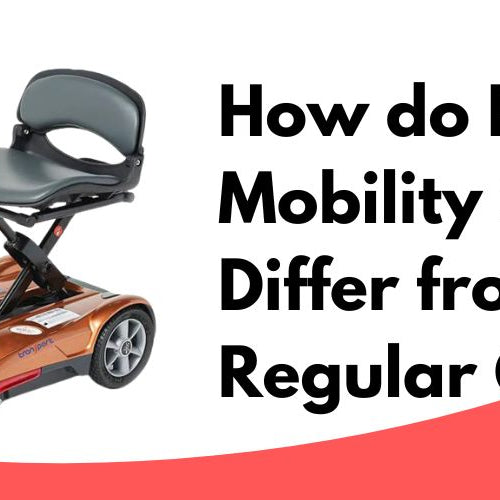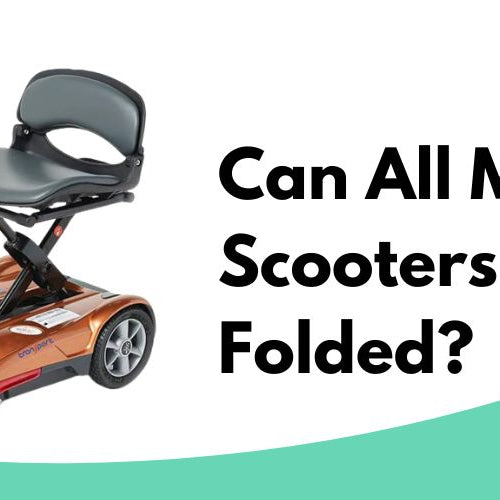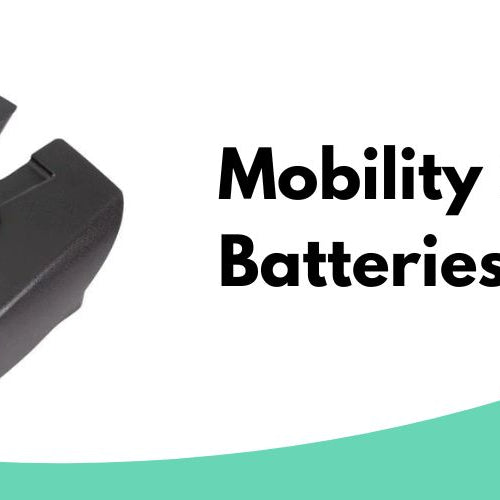Imagine wanting to travel with the convenience and independence of a mobility scooter, but not knowing whether it can fit in your car or not. That's where our discussion comes in, shining a light on the relationship between mobility scooters and cars. Addressing the primary concern, it's essential to know that, yes, mobility scooters can fit in cars. However, a few considerations depend on the specific scooter model and car type, which we will explore further in this article.
The compatibility between a mobility scooter and a car relies heavily on factors such as the scooter's size and weight, your car's available storage space, and any necessary accessories. Before embarking on the journey of finding the right scooter, knowing your car's trunk measurements is crucial. This knowledge will help identify a suitable scooter model that can easily fit and be transported. To further ease the process, some mobility scooter models come apart into smaller sections, allowing for seamless storage and transportation.
Another key aspect to consider is the use of carriers, which can be attached to the car's exterior for additional transportation aid. Ensuring that the selected carrier is compatible with both the scooter model and car is essential. Overall, when looking to answer the burning question of whether mobility scooters can fit in a car, it's clear that they generally can. It's a matter of researching and understanding the specifications and requirements of your specific situation. Armed with this knowledge, you'll be well-equipped to confidently take your mobility scooter with you wherever you go.
Shop our catalog of mobility scooters today at Mobility Nest!
Assessing Mobility Scooter Dimensions
Measuring the Scooter
To determine if a mobility scooter can fit in a car, start by measuring its dimensions. Critical measurements include the scooter's length, width, and height. Most mobility scooters have widths around 21 inches, which should comfortably fit through the door of an SUV. The length, however, can vary depending on the model, with most scooters ranging between 41 and 51 inches long. Keep in mind that these dimensions should be taken without any added accessories or attachments, as these can affect the overall size of the scooter.
Another important aspect to consider is the scooter's weight; medium-sized scooters can weigh over 70 kg. Keep in mind the weight limits of your car, as exceeding them can cause damage or inconvenience.
Vehicle Trunk Space
To ensure a mobility scooter can fit in a car, measure the available trunk space. Account not only for the scooter's dimensions but also for any additional items you may need to store or transport with the scooter such as cushions, accessories, or even a ramp.
When assessing trunk space, also consider these factors:
- The shape of the trunk and whether it will accommodate your scooter's dimensions
- The presence of any obstacles, such as wheel arches or protrusions, affecting storage space
- The ease of loading and unloading the scooter into the car
For those who have cars with fold-down seats or larger trunk openings, fitting a mobility scooter may be more manageable. For instance, SUVs often have ample space with the seats folded down, allowing even longer scooters to fit. Additionally, some small (class 2) scooters can be dismantled, making them easier to transport and store in your car's trunk.
Here are some general guidelines when assessing vehicle trunk space:
- Small Cars: Smaller class 2 scooters or foldable scooters may fit
- Sedans: Foldable or disassembled scooters are more likely to fit
- SUVs: Larger and medium-sized scooters, especially with folded seats or removable parts, are more likely to fit
- Minivans: Most mobility scooter sizes should fit, especially with foldable or removable seating
To make the best decision for your personal situation, it's essential to take accurate measurements and assess the capabilities of your specific car along with the mobility scooter's size and features.
Types of Cars Suitable for Mobility Scooters
Hatchbacks
Hatchbacks can be a good choice for transporting mobility scooters, especially when they have spacious interiors and flat loading surfaces. Some hatchbacks may allow for the scooter to be folded and placed in the trunk or back seat, depending on the scooter model and the car's cargo space. It's important to double-check the dimensions of the specific mobility scooter to ensure it will fit properly in the car.
Mini and Full-Size Vans
Mini and full-size vans are an excellent option for transporting mobility scooters, as they often provide ample space, and some even come equipped with ramps or lifts for easier loading and unloading. Wheelchair accessible vehicles (WAVs) are a popular choice in this category, as they are specifically designed to accommodate mobility scooters and wheelchairs. Some common WAV vans include the Citroen C4 Spacetourer, Ford Galaxy, and Volkswagen Touran. These vans typically offer:
- Lowered floors for better access
- Ramps, lifts, or hoists for easy loading
- Multiple seating configurations for added versatility
SUVs
SUVs can also be suitable for carrying mobility scooters due to their larger cargo areas and higher ground clearance. Some SUVs may be able to accommodate lightweight and collapsible scooters in the trunk, while others may require a trailer hitch carrier to transport larger models. As with hatchbacks, it's crucial to verify the dimensions and weight capacity of both the scooter and the SUV to ensure compatibility.
When selecting a suitable car for a mobility scooter, it's essential to consider the specific needs and preferences of the scooter user, such as:
- Ease of loading and unloading the scooter
- Vehicle cost and fuel efficiency
- Available seating and cargo configurations
In summary, hatchbacks, vans, and SUVs may all serve as viable options for transporting mobility scooters. It's important to research and test each option thoroughly to ensure a safe and convenient fit for both the scooter and its user.
Disassembling a Mobility Scooter
Breaking Down the Components
Disassembling a mobility scooter is a necessary step if you want to fit it in a car. First, fold down the seat to minimize its footprint. Next, remove the basket and battery pack. The process might slightly vary depending on the scooter model, but the general steps are as follows:
- Loosen the tiller and fold it down.
- Lock the tiller into place.
- Identify where to disassemble the main body (if possible).
Typically, there is a lever near the base of the scooter under the seat. Each manufacturer may have a different way of designing their scooters, so it's essential to consult the user manual for specific instructions.
Quick Tips
- Always consult the user manual for your mobility scooter model to ensure proper disassembly.
- Be cautious while disassembling the scooter to avoid damaging any parts.
- Consider using a carrier on your car for some mobility scooter models that cannot be easily disassembled.
When trying to determine if a mobility scooter can fit in a car, consider the following:
- The size and dimensions of your mobility scooter when disassembled
- The available space in your car's trunk
- The possibility of using car carriers or loading ramps for larger scooters
Overall, it is possible to fit a mobility scooter in a car with proper disassembly and some preparation. By breaking down the components and following quick tips, you can successfully transport your scooter and enjoy greater accessibility and mobility.
Transportation Accessories
Carriers and Lifts
Transporting a mobility scooter in a car can be facilitated by using carriers and lifts. These accessories come in various types and sizes to accommodate different scooters and vehicles. Some examples include hitch-mounted carriers, platform lifts, and inside-vehicle lifts. Hitch-mounted carriers are attached to the rear of a vehicle, allowing the scooter to be transported outside the car. Platform lifts, on the other hand, use a powered platform to raise and lower the scooter into the vehicle's trunk or cargo area. Inside-vehicle lifts can be installed in the car's interior, enabling the scooter to be securely stored and transported.
When selecting a carrier or lift, it is essential to:
- Check the compatibility with your vehicle and scooter
- Consider the weight capacity of the lift
- Ensure proper installation by a professional if required
Ramps
Ramps are another accessory that can help transport a mobility scooter in a car. They provide an incline, enabling the scooter user to drive the scooter into the vehicle. Ramps come in many varieties such as telescoping, folding, and roll-up ramps. Some factors to take into consideration when choosing a ramp include:
- Length: A longer ramp will produce a more gradual incline, making it easier to drive the scooter up and into the car
- Width: Ensure the ramp is wide enough to accommodate the scooter's wheels
- Weight capacity: The ramp should be able to handle the scooter's weight without bending or buckling
- Material: Aluminum ramps are lightweight and durable, while rubber ramps provide a non-slip surface
To effectively transport a mobility scooter in a car, it might also be necessary to fold or disassemble the scooter, especially if the vehicle's interior space is limited. Lightweight and collapsible scooters are easier to transport in vehicles, including small cars. Remember to properly secure the scooter inside the car to prevent movement during transit, keeping both the vehicle's occupants and the scooter safe.
Safety Considerations
When considering fitting a mobility scooter into a car, safety should be a top priority. In this section, we will discuss weight and balance, as well as securing the scooter inside the vehicle.
Weight and Balance
Mobility scooters come in various sizes and weights. It's essential to check if your car can accommodate the weight of the scooter, along with any additional equipment needed for transportation. Overloading the car can lead to decreased performance and, potentially, accidents.
- Always check the scooter's weight along with the maximum load limit of your car.
- Distribute the weight evenly inside the vehicle to avoid imbalances.
- Be mindful of the car's total weight, including passengers and other items, when loading a scooter.
To help with weight distribution and balance, consider using a vehicle with a large, flat cargo space or an appropriate scooter carrier.
Securing the Scooter
Once the scooter is inside the vehicle or on a carrier, it's vital to ensure its secure positioning to prevent any movement during transit that could lead to damage or accidents. Here are some tips for securing a mobility scooter safely:
- Use high-quality, adjustable straps or tie-downs to attach the scooter to anchor points within the vehicle or on the carrier.
- Ensure that the brakes on the scooter are engaged during transportation.
- Double-check all straps and connections before and during the journey to ensure they remain tightly fastened.
- Make sure there is enough clearance between the scooter and other objects within the vehicle to prevent damage from any shifting that may occur.
By following these safety guidelines, drivers can ensure that they're transporting mobility scooters securely and safely, minimizing any risks associated with their journey.






Leave a comment